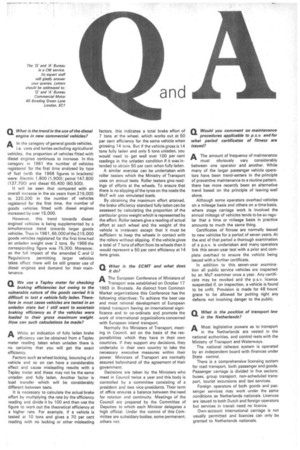Q We use a Tapley meter for checking
Page 99

If you've noticed an error in this article please click here to report it so we can fix it.
braking efficiencies but owing to the vulnerable nature of the goads carried it is difficult to test a vehicle fully laden. Therefore in most cases vehicles are tested in an unladen state but I still want to ascertain braking efficiency as if the vehicles were loaded to their gross maximum weight. How can such calculations be made?
A While an indication of fully laden brake
efficiency can be obtained from a Tapley meter reading taken when unladen there is no certainty that you will get the exact efficiency.
Factors such as wheel locking, bouncing of a vehicle and so on can have a considerable effect and cause misleading results with a Tapley meter and these may not be the same unladen and fully laden. Another factor is load transfer which will be considerably different between tests.
It is necessary to calculate the actual brake effort by multiplying the rate by the efficiency reading and divide it by 100 and then use the fig ire to work out the theoretical efficiency at a higher rate. For example, if a vehicle is tested at 10 tons and gives a 70 per cent reading with no locking or other misleading factors, this indicates a total brake effort of 7 tons at the wheel, which works out at 50 per cent efficiency for the same vehicle when grossing 14 tons. But if the vehicle gross is 14 tons fully laden and only 5 tons unladen, you would need to get well over 100 per cent readings in the unladen condition if it was intended to obtain 50 per cent when fully laden.
A similar exercise can be undertaken with roller testers which the Ministry of Transport uses on annual tests. Roller testers give readings of efforts at the wheels. To ensure that there is no slipping of the tyres on the roads the MoT will use simulated loads.
By obtaining the maximum effort attained, the brake efficiency standard fully laden can be assessed by calculating the proportion of the particular gross weight which is represented by the effort. Roller testers give a reading of actual effort at each wheel and the weight of the vehicle is irrelevant except that it must be sufficient to keep the wheels in contact with the rollers without slipping. If the vehicle gives a total of 7 tons of effort from its wheels then it would represent a 50 per cent efficiency at 14 tons gross.
















































































































































